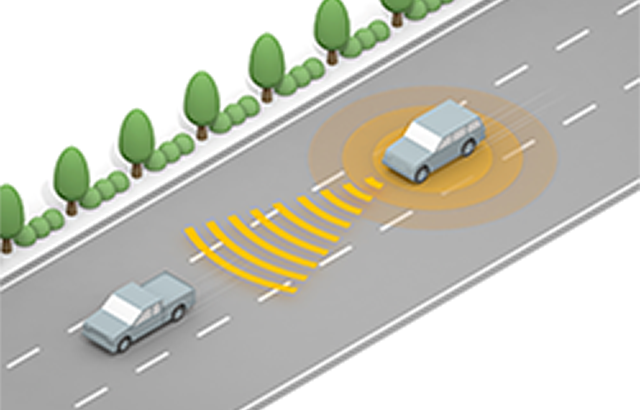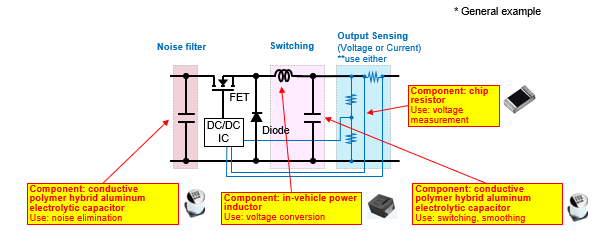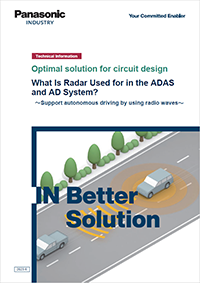What Is Radar Used for in the ADAS and AD System?
– Support Autonomous Driving by Using Radio Waves –
2023-06-23

Radar is one of the sensing technologies indispensable to an advanced driver-assistance system (ADAS) and an autonomous driving (AD) system. A radar device detects an object, obstacle, etc., present around a vehicle, using radio waves. This article discusses the radar used in the ADAS system and AD system and introduces a lineup of electronic components making up a radar system.
1. What Is Radar Used for in the ADAS and AD System?
The ADAS and AD system assist the driver in performing safe driving and relieve the driver’s burden when driving. Radar is one of the technologies incorporated into these systems. It measures the distance to an object, using millimeter radio waves, thus working as a sensor to detect an object in the surrounding area. In-vehicle radars mainly use radio waves with frequencies of 24 GHz, 77 GHz, and 79 GHz. It is expected, however, that for better detection resolution, a radar using a radio wave of a 79 GHz frequency will be in wide use in the future.
In addition to the radar, the ADAS and AD system further include other technical elements, such as cameras, light detection and ranging (LiDAR). Integrating information from these sensing elements, the system recognizes the surrounding environment more accurately and assists the driver in performing safe driving. Combining sensors of different characteristics allows compensating for a drop in the performance of individual sensors put in an unfavorable environment, and allowing for improvement in the overall performance of the system keeping it robust under various environmental conditions.
For example, a camera has a better ability to recognize colors and shapes but its ability to detect a distant object or to detect objects under bad weather is fairly limited. The LiDAR is able to capture the three-dimensional shape of an object with high resolution, but its detection performance drops in bad weather. Radar, on the other hand, is able to detect an object even in bad weather, but is unable to acquire information on the shape or color. In this manner, combining radar with other sensing elements is a general way to ensure improvement in the overall performance of the system.
2. Measurement and object recognition
Radar measures and recognizes objects in the following manner.
<Distance measurement>
Radar emits (radiates) a radio wave toward an object and receives a reflected radio wave from the object to determine the distance to the object. Specifically, radar measures the time span between the emission of the radio wave and reception of the reflected radio wave then calculates the distance to the object using the measured time span.
<Object recognition>
Radar recognizes the object, using the coordinates of the radar at the time of its radio wave emission and distance measurement results. In this process, radar creates an image from a point cloud, thereby identifying the shape and position of the object. Note that, however, radar has relatively low resolution and is therefore incapable of determining the type of the object (person, vehicle, building, etc.). To allow the radar to recognize the object in a more detailed manner, run the radar at a higher frequency to improve its resolution.
3. Trends in the market and demand for the radar
As the number of autonomous cars increases, autonomous driving technology improves, and equipping cars with an automatic braking system becomes mandatory, the number of cars carrying radar is expected to increase. Raising the frequency of millimeter radio waves from radar improves the precision (resolution) of object recognition by radar. However, this involves the risk of increasing data processing volume, which must be carefully avoided. Functions/performance for electronic components used for radars in the future will require "high power," "highly resistant to heat," and "small size and lightweight." The details of these requirements are as follows.
●Higher power
When the amount of data processing increases due to higher resolution, power consumption within a semiconductor device, such as the main CPU, increases as well, thus supplying higher power to said semiconductor device is essential.
●Highly resistant to heat
As an electronic component gets smaller and smaller, its heat per unit area increases. Giving an electronic component high resistance to heat prevents it from degrading due to self-heating or incoming heat from components nearby.
●Smaller in size and weight
In addition to the above challenges, there is a need to reduce the size of electronic components.
4. The circuit configuration of the radar system
4-1. Overall configuration
The radar system is composed of the following components. Fig. 1 shows the system configuration of the radar system.
- High-frequency radio circuit: This is a circuit that transmits/receives millimeter radio waves.
- Antennas: Antennas transmit/receive radio waves. Usually, a transmission antenna amplifies signals by a power amplifier.
- MCU (microcomputer): An MCU gives a control instruction to an external ECU.
- Transceiver: A transceiver is a device or circuit that communicates with external equipment. (CAN communication)
- DC/DC converter: A DC/DC converter converts a voltage from a battery into a voltage each electronic component or circuit needs.

5. Individual circuits and components
5-1. DC/DC converter
In a DC/DC converter circuit, in general, a conductive polymer hybrid aluminum electrolytic capacitor is used to eliminate noise at the input end and to smooth voltage output at the output end, an Automotive power inductor is used for voltage conversion, and a chip resistor (high-precision chip resistor) is used for voltage measurement.
Noise elimination, switching, and smoothing ―― Conductive polymer hybrid aluminum electrolytic capacitor
POINT- ❶ A capacitor offers high capacitance, low ESR, and high ripple-suppression performance, contributing to a reduction in the size of the circuit and an increase in the power capacity (low voltage and large current) of the circuit.
- ❷ Having capacitance characteristics to cut off high-frequency components, the capacitor eliminates a wide range of high-frequency noise that is generated by the high-frequency switching of the circuit.
Voltage conversion ―― Automotive power inductor
POINT- ❶ An inductor made of a metal magnetic material suffers less power loss and carries a large current, contributing to a reduction in the size of the circuit and an increase in the power capacity (low voltage and large current) of the circuit.
- ❷ Having loss characteristics in a higher frequency range (low ACR), the inductor contributes to the suppression of power loss caused by high-frequency switching of the circuit.
Voltage measurement ―― Chip resistor (high-precision chip resistor)
POINT- ❶ A chip resistor with a thin-film structure offers a small resistance tolerance and a low TCR, contributing to high-precision control of the output characteristics of the circuit.

5-2. Transceiver I/F
As shown in Fig. 3, a transceiver circuit communicates with external equipment (CAN, Ethernet, etc.) through two lines. To run this circuit normally, you need to be careful with static electricity and noise. Static electricity or noise entering the circuit through the communication line affects the circuit and in a worst-case scenario, may cause its electronic component to fail. Usually, therefore, the circuit is provided with a chip varistor and an ESD suppressor serving as electrostatic control measures.
Electrostatic control ―― Chip varistor、ESD suppressor
POINT- ❶ With a wide range of capacitance characteristics, these components suppress electrostatic noise (ESD) while keeping the communication quality of the circuit intact.
- ❷ With its capacitance ranging from 8 pF to 250 pF, the chip varistor operates effectively at low and high communication speeds.
- ❸ With a capacitance of 0.1 pF, the ESD suppressor operates effectively at high communication speed.

6. Summary
Radar is an important system that recognizes an object and measures the distance to an object. As autonomous driving cars grow in number and the level of autonomous driving improves further, cars equipped with Radar is expected to increase.
To improve radar's precision in object recognition, it is necessary to increase the frequency of millimeter waves from radar to raise its resolution. Radio waves with a higher frequency, however, lead to a greater data processing volume, thus leading to increasing power loss by electronic components, which is a problem that needs to be carefully avoided. In the future, in-vehicle electronic components will face these demands: "large current," "low loss," "high frequency," and "small size," Panasonic Industry offers a wide variety of products for use in radars (Table 1).
| Component | Feature | Large current | Low loss | High frequency | Small size | High precision |
|---|---|---|---|---|---|---|
Conductive polymer hybrid aluminum electrolytic capacitor |
Low ESR High reliability |
✔ | ✔ | ✔ | ✔ | |
Automotive power inductor  |
Large current, low loss High reliability |
✔ | ✔ | ✔ | ✔ | |
Chip resistor (high-precision chip resistor)  |
High precision, high resistance to heat |
✔ | ✔ | |||
Chip varistor |
Chip varistor | ✔ | ||||
ESD suppressor |
Low capacitance Ultrafast data I/F |
✔ | ✔ |


